
Resynchronization of Data for OXI_HUB
Once the OXI configuration is completed, you are ready for data synchronization. To access the Resync option for 2-way interfaces go to Utilities>Resync.
After a new system installation, data synchronization between the external system and OPERA is necessary. For this purpose you need to decide whether OPERA or the external system is the master and has the more accurate data. If OPERA were the master, you would consider an initial resync of all OPERA data to the external system via OXI to establish an equal inventory in both systems.
In this case the Resync should be run one option after another in the following sequence:
The Resync options can be run individually and in no particular sequence at any time if you simply want to resync specific data to the external system. The reason for this can be, for example, to send all reservations that have not received an external system number during the original transmission. Again it is recommended that reservations be only resynced once it is certain that the respective rate codes, blocks, and profiles have been built in the external system.
You have to select either a date range or once of the confirmation number options (external or OPERA) in order to resync reservations.
Example: Reservation tab for Resync Global level.
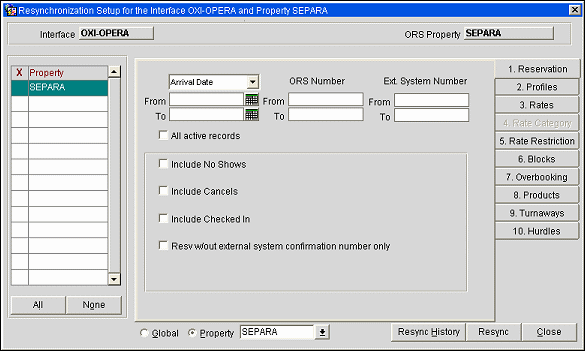
Arrival Date From. Select the first arrival date for the reservation resync.
Arrival Date To. Select the last arrival date for the reservation resync.
Ext System Number From. Specify an external system confirmation number to resync. You can enter a single number or multiple numbers separated by comma.
Ext System Number To. This field contains the external system confirmation in case you want to specify a range from number/to number.
OPERA Number From. Specify an OPERA confirmation number to resync. You can enter a single number or multiple numbers separated by comma.
OPERA Number To. This field contains the OPERA confirmation in case you want to specify a range from number/to number.
All Active Records. Select if no other conditions are to be met except resynching active records.
Note: This option will also sync shares created in ORS and successfully picked up in OPERA when the parameter FULL OPERA SHARES=Y.
Include No Shows. Select to include no shows in your resync.
Include Cancels. Select to include the cancels in your resync.
Include Checked In. Select to include the checked-in guests in your resync.
Reservations without external system confirmation number only. Select to resync only reservations without external system confirmation number. If this is unchecked, all reservations will be resynced.
Resync History. Select this button to view when the resync option had last been executed and its status. This will display all resync options that have been executed.
Resync. Select this button to start the resync process. This will execute the resync according to the filters you have set.
Example: Global level Profile resync.
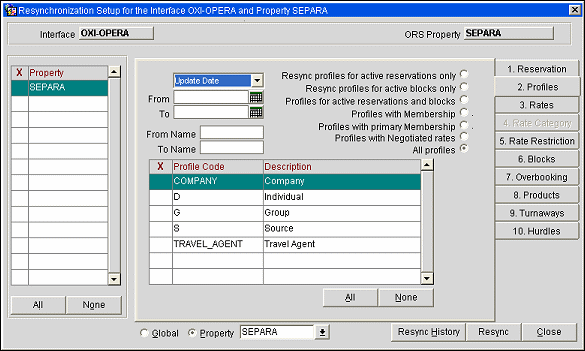
Interface. Displays the global interface ID you have selected.
ORS Property. Displays the selected property. Select a property that is linked to your selected interface by selecting the left column next to the ‘property’ name until an X occurs. Resync is only possible if properties have been selected. The All and None buttons allow the selection/deselection of all properties at once.
Date Type. Use this menu to select a date type for the resync process. The options contained within this field are Update Date (use to resync profiles that have been modified within the selected From/To dates entered) or Created Date (use to resync profiles that were created within the parameters of the From/To dates entered).
Note: When no profiles have been modified within the selected From/To dates entered, resync will consider the Created date.
From/To Date. Enter a From and To date to resync only the profiles that fall within these dates.
From Name. Type the specific name of the profile to be resynced.
Note: When used in conjunction with To Name with the same entry in both fields, the resync will only send profiles with exactly that name.
To Name. Type the specific name of the profile to be resynced. The query takes all names BETWEEN the letters in “From Name” and “To Name”. Sample: You have typed ‘A’ into “From Name” and ‘G’ into “To Name”. That means that, for example, GA would not be taken into account anymore and the resync would only include the latest name with F (e.g., FZ).
Resync profiles for active reservations only. Selecting this check box will send only profiles that are attached to active reservations.
Resync profiles for active blocks only. Selecting this check box will send only profiles that are attached to active blocks.
Profiles for active reservations and blocks. Selecting this check box will send profiles that are attached to active reservations and blocks.
All Profiles. Selecting this check box will resync all profiles, regardless whether they are linked to active reservations and blocks or not.
Note: Select the proper Profile Code for your resync to minimize the data flow, as the hotel could have a huge profile database that would lead to a very long resync process.
You have to select either a date range or check the rate codes in order to resync rates.
Example: Global level Rates resync.
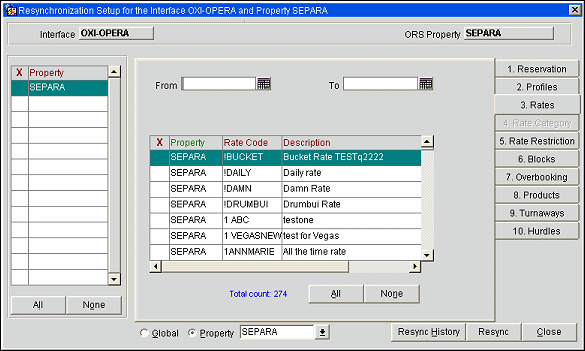
From Start Date. Select the first rate code start date for the resync. Only rate codes valid for this date will be shown.
To Start Date .Select the last rate code start date for the resync. Only rate codes valid for this date will be shown.
Total Count. Shows how many active rate codes you have in the OPERA database. Once you have selected a date range the count is adjusted to match the number of rate codes that fall into your selected date range.
Note: You can select the rate codes for your resync individually by selecting the respective record.
This is currently not activated and will be available in a future OXI version.
You have to select a date range in order to resync rate restrictions.
Example: Rate Restrictions on Global Level.
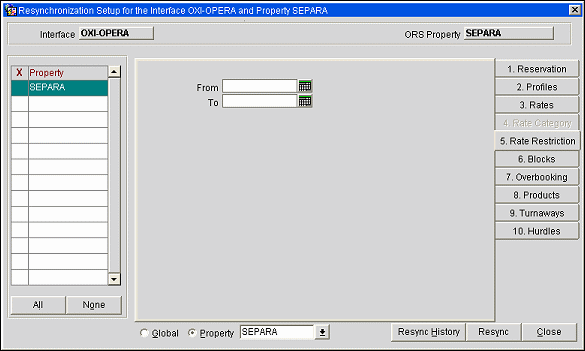
From Start Date. Select the first restriction start date for the resync.
To Start Date. Select the last restriction start date for the resync.
Rate Category. A multi-select list of configured rate categories opens when you select this option.
Rate Code. A multi-select list of configured rate codes opens when you select this option.
Example: Blocks on Global level.
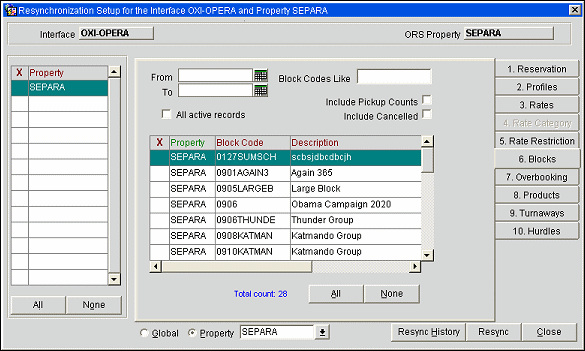
From Start Date. Select the first restriction start date for the resync.
To Start Date. Select the last restriction start date for the resync.
Block Codes Like. Enter a specific block code or a starting letter following by a % in order to filter your search.
Include Pickup Counts. Select only if the external system requires the pickup counts within the block message. This would be the case if you were resyncing a block without resyncing all its reservations afterwards. For initial cutover resync we do not recommend including the pickup counts, as reservations may be subsequently resynced and this automatically updates the pickup count in the blocks.
Include Cancelled Blocks. Select to include canceled blocks. This could be needed for initial cutover resyncs where both systems should have all blocks including the canceled ones, in case these may be reinstated.
Total Count. Shows how many active blocks you have in the OPERA database. Once you have selected a date range the count is adjusted to match the number of blocks that fall into your selected date range.
Note: You can select the block codes for your resync individually by clicking on the respective record.
Example: Overbooking resync on Global level.
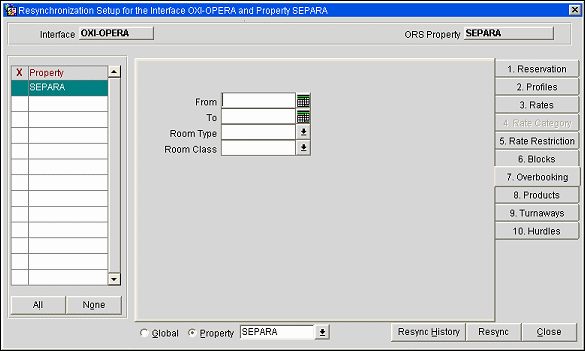
Interface. Displays the global interface ID you have selected.
ORS Property. Will be displayed only if the Resync was entered with the Property selected at login time.
From Start Date. Select the first restriction start date for the resync.
To Start Date. Select the last restriction start date for the resync.
Room Type. A multi-select list of configured room types opens when you select this option.
Room Class. A multi-select list of configured room classes opens when you select this option.
This synch is only available from ORS to OPERA PMS.
Example: Products resync.
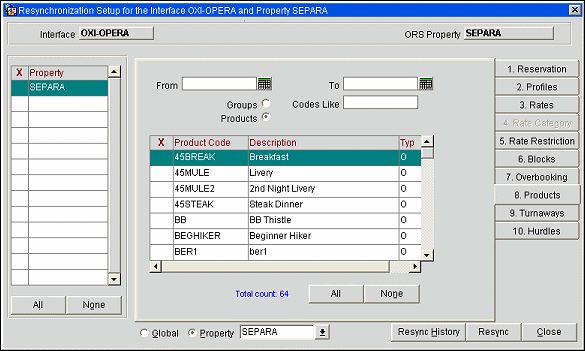
From. Select the start date for the resync.
To. Select the end start date for the resync.
Codes Like. Free format field for whole or partial word search.
Groups. Filter option to find only Packages linked to groups.
Products. Filter option to find only Packages not linked to groups. This option is usually the most desired for Resync choice and is the default upon entering this screen.
Global/Property. Filter for Global Packages that can be sent to any OPERA property or specifically by Property.
Example: Resync for Turnaways.
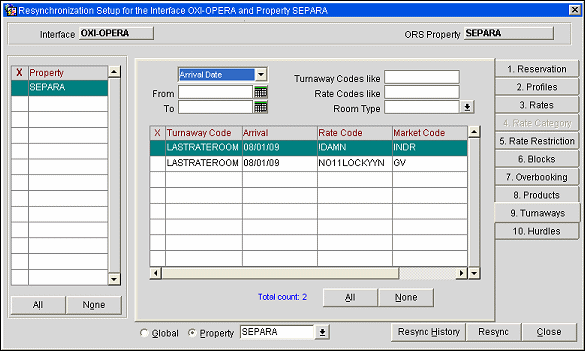
Arrival/Update/Created Date. Select from the pull-down menu which date range to use; Arrivals, Updates, or Created on.
From Date. Select the first restriction start date for the resync.
To Date. Select the last restriction start date for the resync.
Turnaway Codes Like. Enter all or part of a turnaway code to be resynced.
Rate Codes Like. Enter all or part of a rate code to be resynced.
Room Type. Select from the pull-down menu a room type to filter turnaway codes by.
Example: Resync for Hurdles.
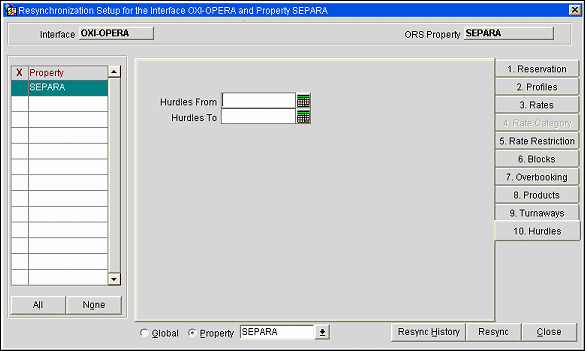
Hurdles From/To Date. Enter a From and To Date range to resync hurdles.
For any resync that executes, a record is created in the resync history table. This history record can assist you in keeping track of all resyncs done and their status.
Example: Resync History.
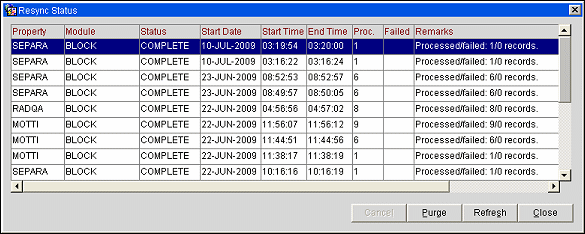
Module. Resync module that was used
Status. Status of resync. Options are:
Purge. Manual purge of the entire resync history. Only resyncs that have not been completed yet will be excluded from the deletion. A warning occurs that has to be confirmed before the purge is performed.
The purpose of the Inventory Reconciliation Utility in ORS is to allow users to synchronize reservations and blocks between ORS and PMS. A summary of overall sold records can be requested for either one or multiple properties at a time. If discrepancies are noted, users can drill further into room type specific comparison and even display single reservations and blocks to analyze where the imbalance occurs.